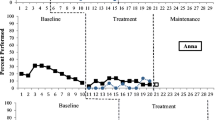Abstract
The current study evaluated the effects of training Big 6 + 6 motor skills on untrained daily living skills. Precision teaching suggests that improved speed of component behaviors can lead to better performance of composite skills. Researchers used a pre-post probe single-subject design to evaluate the effects of frequency building on the motor tasks of push and grasp, as well as the associated effects on the composite skills prior to and following intervention on the component skills. Results suggest that the participant increased his frequencies on all of the component skills. The speed and accuracy of composite skills were higher following the intervention. Researchers also assessed for generalization to other significant contexts.


Similar content being viewed by others
References
Binder, C., Haughton, E., & Bateman, B. (2002). Fluency: Achieving true mastery in the learning process. Professional Papers in Special Education, 2–20.
Cihon, T. M. (2007). A review of training intraverbal repertoires: Can precision teaching help? The Analysis of Verbal Behavior, 23(1), 123–133. https://doi.org/10.1007/BF03393052.
Cooper, J. O., Heron, T. E., & Heward, W. L. (2007). Applied behavior analysis. Upper Saddle River, NJ: Merrill/Prentice Hall.
Desjardins, A. (1995). Teaching fine motor skills: Big 6 + 6. Seattle: Morningside Academy.
Eastridge, D., & Mozzoni, M. P. (2005). Fluency and functional motor skills following brain injury. Behavioral Interventions, 20(1), 77–89. https://doi.org/10.1002/bin.175.
Fabrizio, M. A., Schirmer, K., King, A., Diakite, A., & Stovel, L. (2007). Precision teaching a foundational motor skill to a child with autism. Journal of Precision Teaching and Celeration, 23, 16–18.
Lindsley, O. R. (1992). Precision teaching: Discoveries and effects. Journal of Applied Behavior Analysis, 25(1), 51. https://doi.org/10.1901/jaba.1992.25-51.
Pennypacker, H. S., & Lindsley, O. R. (2003). Handbook of the standard celeration chart. Cambridge Center for Behavioral Studies. Concord, MA
Pennypacker, H. S., Gutierrez Jr, A., & Lindsley, O. R. (2003). Handbook of the Standard Celeration Chart. Cambridge Center for the Behavioral Sciences. Concord, MA.
Twarek, M., Cihon, T., & Eshleman, J. (2010). The effects of fluent levels of Big 6+ 6 skill elements on functional motor skills with children with autism. Behavioral Interventions, 25(4), 275–293. https://doi.org/10.1002/bin.317
Wechsler, D. (2003). Wechsler Intelligence Scale for Children (4th ed.). San Antonio, TX: The Psychological Corporation.
Author information
Authors and Affiliations
Corresponding author
Ethics declarations
Conflict of Interest
No authors have a conflict.
Ethical Approval
All procedures performed in studies involving human participants were in accordance with the ethical standards of the institutional and/or national research committee and with the 1964 Helsinki declaration and its later amendments or comparable ethical standards.
Informed Consent
Informed consent was obtained from all individual participants in the study.
Additional information
Publisher’s Note
Springer Nature remains neutral with regard to jurisdictional claims in published maps and institutional affiliations.
Implications for Practice
• Precision teaching (PT) on the Big 6 + 6 fine motor skills can be an effective procedure for increasing the frequency of execution of composite skills.
• Retention, endurance, application, and stability outcomes can be used to assess the effects of the training on the target composite skill.
• Interventions based on the Big 6 + 6 can be a viable strategy for promoting the independence of individuals with intellectual disabilities, through generalization of routines in a home setting.
• The procedure appears to be efficient in providing the anticipated results in a relatively short time.
Rights and permissions
About this article
Cite this article
Vascelli, L., Iacomini, S., Gueli, G. et al. The Effects of the Big 6 + 6 Skills Training on Daily Living Skills for an Adolescent With Intellectual Disability. Behav Analysis Practice 13, 955–960 (2020). https://doi.org/10.1007/s40617-020-00471-6
Published:
Issue Date:
DOI: https://doi.org/10.1007/s40617-020-00471-6




